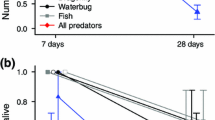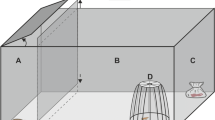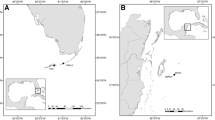Abstract
Densities and species composition of predators could affect morphological defences, larval development and the timing of emergence of their prey. To address this issue we studied the morphology and life history of an ephemerellid mayfly, Ephemerella invaria, from two streams in a deciduous forested drainage basin in central New York. Both streams contained predatory fish, but densities and species composition of fish differed. A field survey provided evidence that Ephemerella inhabiting a stream with ≥10 fish species and high relative densities of fish emerged several weeks earlier and at smaller sizes than Ephemerella inhabiting a nearby tributary with ~2 fish species and low relative densities of fish. However, the two populations of mayflies showed no differences in defensive morphology or growth rates. In laboratory rearing experiments, we exposed Ephemerella larvae from these two locations to fish chemical cues or control water (no fish) over 2 months to test whether differences in life histories could be attributed to fish. Fish cues induced faster larval development, but also smaller size of mature Ephemerella individuals from both high and low predator locations. Although shorter development times in more dangerous environments could increase larval survival, smaller size of females results in a fecundity cost associated with this life history shift. Consistent with the field studies, laboratory rearing experiments revealed no effects of fish cues on Ephemerella's morphological defences. These data suggest that variation in the density or species composition of predators may favour the evolution of developmental plasticity to reduce mortality in the larval environment.




Similar content being viewed by others
References
Appleton RD, Palmer AR (1988) Water-borne stimuli released by predatory crabs and damaged prey induce more predator-resistant shells in a marine gastropod. Proc Natl Acad Sci USA 85:4387–4391
Arnqvist G, Johansson F (1998) Ontogenetic reaction norms of predator-induced defensive morphology in dragonfly larvae. Ecology 79:1847–1858
Bechara JA, Moreau G, Planas D (1993) The impact of brook trout (Salvelinus fontinalis) on an experimental stream community: the role of spatial and size refugia. J Anim Ecol 62:451–464
Bohlin T (1984) Quantitative electrofishing for salmon and trout – views and recommendations. Information från Sötvattenslaboratoriet, Drottningholm 4:1-33
Bradshaw WE, Johnsson K (1995) Initiation of metamorphosis in the pitcher-plant mosquito: effects of larval growth history. Ecology 76:2055–2065
Brittain JE (1982) Biology of mayflies. Annu Rev Entomol 27:119–147
Brönmark C, Miner JG (1992) Predator-induced phenotyphical change in body morphology in crucian carp. Science 258:1348–1350
Crowl TA, Covich AP (1990) Predator-induced life-history shifts in a freshwater snail. Science 247:949–951
Dahl J (1998a) The impact of vertebrate and invertebrate predators on a stream benthic community. Oecologia 117:217–226
Dahl J (1998b) The importance of predation in benthic stream communities. PhD dissertation, Lund University, Sweden
Dahl J, Peckarsky BL (2002) Induced morphological defenses in the wild: predator effects on a mayfly Drunella coloradensis. Ecology 83:1620–1634
Delucchi CM (1988) A comparison of community structure, life histories and movement patterns of benthic macroinvertebrates between permanent and temporary streams. PhD dissertation, Cornell University, Ithaca, N.Y., USA
Delucchi CM, Peckarsky BL (1989) Life history adaptations of insects in a temporary stream. J N Am Benthol Soc 8:308–321
Diehl S, Cooper SD, Kratz KW, Nisbet RM, Roll SK, Wiseman SW, Jenkins TM (2000) Effects of multiple, predator-induced behaviors on short-term producer-grazer dynamics in open systems. Am Nat 156:294–313
Dodson SI (1984) Predation of Heterocope septentrionalis on two species of Daphnia: morphological defences and their cost. Ecology 65:1249–1257
Douglas PL, Forrester GE, Cooper SD (1994) Effects of trout on the diel periodicity of drifting in baetid mayflies. Oecologia 98:48–56
Endler JA (1986) Defence against predators. In: Feder ME, Lauder GV (eds) Predator-prey relationships. University of Chicago Press, Chicago, pp 109–134
Flecker AS, Allan JD, McClintock NL (1988) Male body size and mating success in swarms of the mayfly, Epeorus longimanus. Holarctic Ecol 11:280–285
Forrest TG (1987) Insect size tactics and development strategies. Oecologia 73:178–184
Forrester GE (1994) Influence of predatory fish on the drift dispersal and local density of stream insects. Ecology 75:1208–1218
Goodbrod JR, Goff ML (1990) Effects of larval population density on rates of development and interactions between two species of Chrysomya (Diptera: Calliphoridae) in laboratory cultures. J Med Entomol 27:338–343
Harvell CD (1984) Predator-induced defense in a marine bryozoan. Science 224:1357–1359
Harvell CD (1990) The ecology and evolution of inducible defenses. Q Rev Biol 65:323–340
Kohler SL, McPeek MA (1989) Predation risk and the foraging behaviour of competing stream insects. Ecology 70:1811–1825
Lardner B (2000) Morphological and life history responses to predators in larvae of seven anurans. Oikos 88:169–180
Levins R (1962) Theory of fitness in a heterogeneous environment. I. The fitness set and adaptive function. Am Nat 96:361–378
Levins R (1968) Evolution in changing environments. Princeton University Press, Princeton, N.J.
Lima SL, Dill LM (1990) Behavioural decisions made under the risk of predation: a review and prospectus. Can J Zool 68:619–640
Lively CM (1986) Predator-induced shell dimorphism in the acorn barnacle, Chthamalus anisopoma. Evolution 40:232–242
McIntosh AR, Peckarsky BL (1999) Criteria determining behavioural responses to multiple predators by a stream mayfly. Oikos 85:554–564
McIntosh AR, Townsend CR (1994) Interpopulation variation in mayfly antipredator tactics: differential effects of contrasting predatory fish. Ecology 75:2078–2090
McPeek M, Peckarsky BL (1998) Life histories and the strength of species interactions: combining mortality, growth, and fecundity effects. Ecology 79:867–879
Nijhout HF (1999) Control mechanisms of polyphenic development in insects. Bioscience 49:181–192
Peckarsky BL (1985) Do predaceous stoneflies and siltation affect the structure of stream insect communities colonising enclosures? Can J Zool 63:1519–1530
Peckarsky BL (1987) Mayfly cerci as defense against stonefly predation: deflection and detection. Oikos 48:161–170
Peckarsky BL, McIntosh AR (1998) Fitness and community consequences of avoiding multiple predators. Oecologia 113:565–576
Peckarsky BL, Penton MA (1988) Why do Ephemerella nymphs scorpion posture: a "ghost of predation past"? Oikos 53:185–193
Peckarsky BL, Cowan CA, Penton MA, Anderson CR (1993) Sublethal consequences of stream-dwelling predatory stoneflies on mayfly growth and fecundity. Ecology 74:1836–1846
Peckarsky BL, Taylor B, McIntosh AR, McPeek MA, Lytle DA (2001) Variation in mayfly size at metamorphosis as a developmental response to risk of predation. Ecology 82:740–757
Peckarsky BL, McIntosh AR, Taylor BW, Dahl J (2002a) Predator chemicals induce changes in mayfly life history traits: a whole-stream manipulation. Ecology 83:612–618
Peckarsky BL, McIntosh AR, Caudill CC, Dahl J (2002b) Stabilizing selection on male body size of high altitude populations of Baetis bicaudatus (Ephemeroptera: Baetidae). Behav Ecol Sociobiol 51:530–537
Petranka JW, Kats LB, Sih A (1987) Predator-prey interactions among fish and larval amphibians: use of chemical cues to detect predatory fish. Anim Behav 35:420–425
Pettersson LB (1999) Phenotypic plasticity and the evolution of an inducible morphological defence in crucian carp. PhD dissertation, Department of Ecology, Lund University, Sweden
Reimer O, Tedengren M (1996) Phenotypical improvment of morphological defences in the mussel Mytilus edulis induced by exposure to the predator Asterias rubens. Oikos 75:383–390
Scott DE (1994) The effects of larval density on adult demographic traits in Ambystoma opacum. Ecology 75:1383–1396
Semlitsch RD, Scott DE, Pechmann JHK (1988) Time and size at metamorphosis related to adult fitness in Ambystoma talpoideum. Ecology 69:184–182
Sih A, Crowley PH, McPeek MA, Petranka JW, Strohmeier K (1985) Predation, competition and prey communities: a review of field experiments. Annu Rev Ecol Syst 16:269–311
Simmonds JSJ, Blaney WM (1986) Effects of rearing density on development and feeding behaviour of larvae of Spodoptera exempta. J Insect Physiol 32:1043–1053
Skelly DK, Werner EE (1990) Behavioural and life-historical responses of larval American toads to an odonate predator. Ecology 71:2313–2322
So PM, Dudgeon D (1989) Variations in the life-history parameters of Hemipyrellia ligurriens (Diptera: Calliphora) in response to larval competition for food. Ecol Entomol 14:109–116
Soluk D (1990) Postmolt susceptibility of Ephemerella larva to predatory stoneflies: constraints on defensive armour. Oikos 58:336–342
Sweeney BW, Vannote RL (1981) Ephemerella mayflies of White Clay Creek: bioenergetics and ecological relationships among six coexisting species. Ecology 62:1353–1369
Tollrian R, Harvell CD (1999) The ecology and evolution of inducible defenses. Princton University Press, Princeton, N.J.
Wilbur HM, Fauth JE (1990) Experimental aquatic food webs: interactions between two predators and two prey. Am Nat 135:176–204
Acknowledgements
We thank Glenn Howser and Phil Kaufman at the Schwardt Laboratory for help during the induction experiment. We thank also Christer Brönmark, Andrea Encalada, Lawrence Dill and Kajsa Åbjörnsson for providing critical comments on the manuscript. Financial support was received from the Swedish Natural Science Research Council (STINT) to J. Dahl and NSF Grant (DEB96-29404) to B. Peckarsky.
Author information
Authors and Affiliations
Corresponding author
Rights and permissions
About this article
Cite this article
Dahl, J., Peckarsky, B.L. Developmental responses to predation risk in morphologically defended mayflies. Oecologia 137, 188–194 (2003). https://doi.org/10.1007/s00442-003-1326-0
Received:
Accepted:
Published:
Issue Date:
DOI: https://doi.org/10.1007/s00442-003-1326-0




